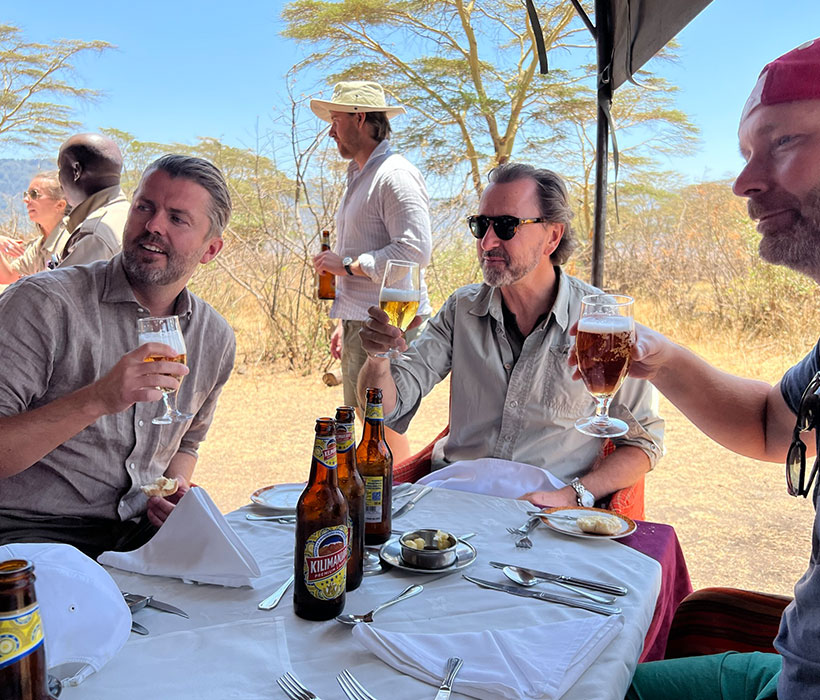When You Plan for Tanzania, the first thing that comes in your mind is African Wildlife Especially for the African Big Five. Tanzania Safari is Worldwide Famous for Wildlife and Rich biodiversity.

“African big five” are the special attraction in Tanzania, for their aggressiveness, structure, and behaviour, but we should not avoid the African Small Five because they also have some special physical characteristics and behaviour, which make them Unique Species in African Wildlife. Here you can get the interesting facts Of African Small Five:
1 # Elephant Shrew or Jumping Shrews

Some interesting facts about Know about Elephant shrew:
- Elephant shrews also are known as sengis, the different types of Name based upon the location such as the checkered elephant shrew in Central Africa, the golden-rumped elephant shrew in Kenya, grey-faced elephant shrew in Tanzania, and the black and rufous elephant shrew in East Africa.
- Elephant shrew can found in scrub, dry forests, savannas, and rocky outcrops areas.
- They also found in South Africa, Botswana, Mozambique, and in Zimbabwe.
- They have a point-headed, long elephant trunk-like nose, so it named Elephant shrew.
- It is the cutest among all African little five, as it looks like a small mouse with a length of 22cm to 30cm, including its tail and has weight varies 25 to 700grams according to the species.
- Their rear legs are longer than other legs and have a scaly tail, large eyes, and ears.
- The life span of the jumping shrew is an average of 2 to 4 years. As they can jump up to 3 feet into the air, they are also known as jumping shrew.
- As it is an insectivorous mammal, they eat worms, grubs, spiders, ants, and termites. They also feed on fruits, seeds, and leaves.
- Lizards, Snakes, and birds of prey like Eagles, Hawks, Vultures, etc. are the predators of elephant shrew.
- There are 20 species of elephant shrew with different sizes and colors in Africa.
- Most of the elephant shrews spend their time outside at the time between day and night.
- The elephant shrew is active during the day and runs very fast.
- The elephant shrew has an excellent sense of hearing, smell, and eyesight, uses it to detect food and predators.
- Socially, they defend themselves or their territory against other elephant shrews.
2 # Buffalo Weaver

Some interesting facts about Buffalo Weaver:
- Buffalo Weaver is a common bird that you can see in Africa with three different species like Red-billed buffalo weaver, White-billed buffalo weaver, and White-headed buffalo weaver. Only in Tanzania, you can find all types of buffalo weaver birds.
- Red-billed buffalo weaver can found in Eastern Africa, Southern Africa, and the northern part of South Africa. White-billed buffalo weaver can found in the south of the Sahara desert, whereas the White-headed buffalo weaver can found in Eastern Africa.
- Habitat for buffalo weaver is dry savannah, open thorn scrub forests, and acacia woodland areas.
- Red-billed buffalo weaver has a red bill; shoulders colored with white, and have black plumage. Length of 23 cm and weight varies from 65 to 80 grams for all species of buffalo weavers.
- White-billed buffalo weaver has a length of 23 to 24 cm with white flecking on the back and wings whereas, white-headed buffalo weaver is brown and white, have a red rump, and vent.
- They made their thick and strong nest with coarse grasses as colonies with a separate room in woods, especially in a baobab tree.
- Due to their hit and grabbing technique for food and their strong and thick nest; they are named as “Buffalo weaver”.
- They feed on insects, fruits, and seeds.
- The most amazing fact about buffalo weaver is they have a Phalloid organ with no blood vessel and sperm, which means false penis, only to attract the opposite sex.
- They often live in large colonies, and you can easily spot them during your Tanzania safari Tours because of their loud noise.
3 # Rhinoceros Beetle

Some interesting facts about Rhinoceros Beetle:
- Rhinoceros Beetle or Rhino Beetle is the largest species among all of the beetle species in the world.
- Its other names are Hercules, unicorns, or horn beetles.
- Located in Eastern Africa, both males, as well as females, have curvy horns on their heads.
- As Rhinoceros have the horns, they also have horns with similar structures, one on the top of the head, and the other one is from the middle of thorax. So it is named Rhino Beetle.
- Rhino beetle is not only the largest beetle of the world but also the strongest Insect Species in the world because they can lift 850 times of its own weight, where an elephant can’t lift up more than 25 times of its own weight.
- It may look like a scary little one, but they do not sting or bite to humans.
- Despite having wings, they can’t fly, but they use it to make hissing sound by rubbing wings ends with the abdomen.
- The lifespan of 2 to 5 years, including larval stages, has a length of 6 cm and a weight of 30 to 40 grams.
- Nectar, fruit, and plant’s fluid or saps are the food of rhino beetle.
- The most amazing thing that the male Rhino beetles fight to get the attention of female rhino beetles.
- Snakes and birds are predators to them.
- When rhino beetle sense any danger, it buries itself under the ground.
- It is also located in the USA and Asia.
4 # Leopard Tortoise

Some interesting facts about Leopard Tortoise:
- Leopard Tortoise is the largest among the African small five and fourth-largest species in the world.
- You can find Leopard Tortoise during Tanzania Safari, and they can found across eastern and southern Africa.
- They have a black and yellow spotted shell, which gave them the name Leopard Tortoise.
- In Kruger National Park, You can find them in the camps, or on the roads.
- They are the habitat of the coastal plains, semi-arid grasslands, sub-Sahara Africa, and also in scrublands.
- Length of Leopard Tortoise varies between 16 to 28 inches and weight, 40 to 120 pounds.
- Due to paddle-shaped front legs and big rear legs, they can easily move in rock areas.
- Leopard Tortoise feeds on grass, mushroom, fruits, juicy plants or sap, and prickly pear cactus.
- Wild cats, dogs, and humans are the predators of this species. People in Africa ate it due to its delicious flesh.
- To survive from extremely cold and hot weather, they hide inside the abandoned tunnel or hole.
- With a life span of 80 to 100 years, it consumes old bone to keep shells in good condition.
- The base of the shell is flat in the case of the female, where it is concave, in male case.
- This is the only tortoise that does not have a Nuchal or protective shield above the neck, which makes it the only tortoise that can raise the head and also can swim.
5 # Antlion

Some interesting facts about Ant Lion:
- Among all of the African little five, Ant lion is the smallest one that you can find during your Tanzania Safari Tours.
- The Most aggressive and fierce among all of the African Small Five, Ant Lion Carries the mostly similar behavioral characteristic of a lion by the name – Ant Lion.
- In the world, there are 2000 species are Available that can found.
- The Antlion is the name of the larval stage of the lifecycle of an insect, in which larvae becomes aggressive when waiting for the hunt in sandy or dry areas.
- In Africa, Antlion can be found in Namibia, Tsavo in Kenya and Tarangire in Tanzania.
- The length of fully grown larvae is 1.5 cm, whereas 4 cm length and a wingspan of 8 cm in case of an adult.
- Before adults, their larva becomes maximum size and goes in the process of metamorphosis to become a structure like a caterpillar.
- Their marks look like cone-shaped in the areas of sand or dry soil.
- Cricket, birds, and insectivores are predators to them.
- They are the habitat of sandy areas like the beach, dry soil.
We hope you have got some interesting information about the African small five and their special quality to being among the popular ones. If you are lucky, you may meet these African small five in your way of Tanzania safari. For More Information about Tanzania Safari Tours Visit @ https://lifetimesafaristz.com/
Related Post


















